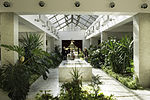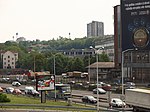Museum of Yugoslavia
1996 establishments in SerbiaInstances of Lang-sr using second unnamed parameterMuseums established in 1996Museums in BelgradeSavski Venac ... and 1 more
Socialist Federal Republic of Yugoslavia

The Museum of Yugoslavia (Serbian: Музеј Југославије, romanized: Muzej Jugoslavije) is a public history museum in Belgrade, the capital of Serbia. It chronicles the period of Kingdom of Yugoslavia and Socialist Yugoslavia as well as the life of Josip Broz Tito. Tito's grave is located in one of the museum buildings (the House of Flowers). With 120,000 visitors annually, it is the most visited museum in Serbia.
Excerpt from the Wikipedia article Museum of Yugoslavia (License: CC BY-SA 3.0, Authors, Images).Museum of Yugoslavia
Михаила Мике Јанковића, Belgrade Београд (Савски венац) (Savski Venac Urban Municipality)
Geographical coordinates (GPS) Address Phone number Website External links Nearby Places Show on map
Geographical coordinates (GPS)
| Latitude | Longitude |
|---|---|
| N 44.786666666667 ° | E 20.451666666667 ° |
Address
Музеј Југославије
Михаила Мике Јанковића 6
11000 Belgrade, Београд (Савски венац) (Savski Venac Urban Municipality)
Central Serbia, Serbia
Open on Google Maps







